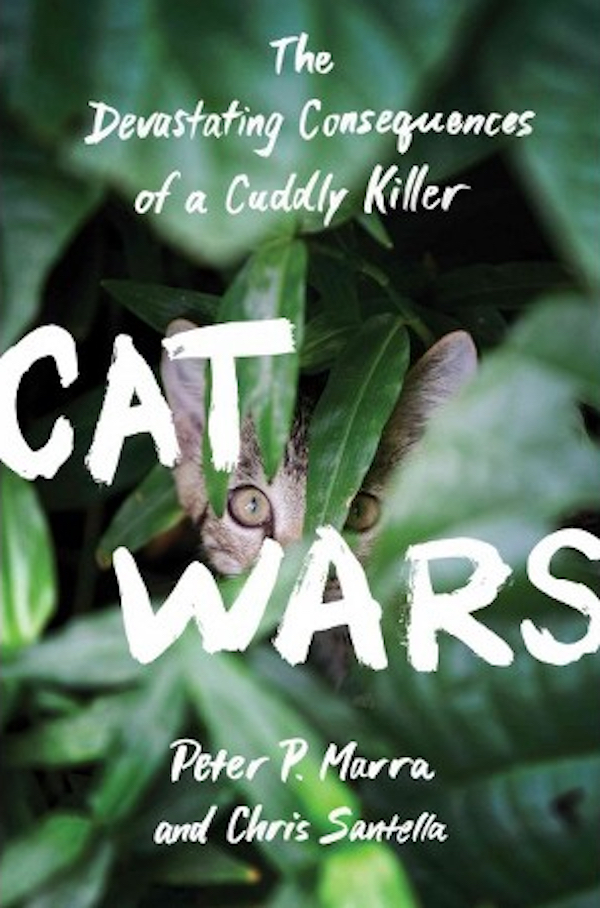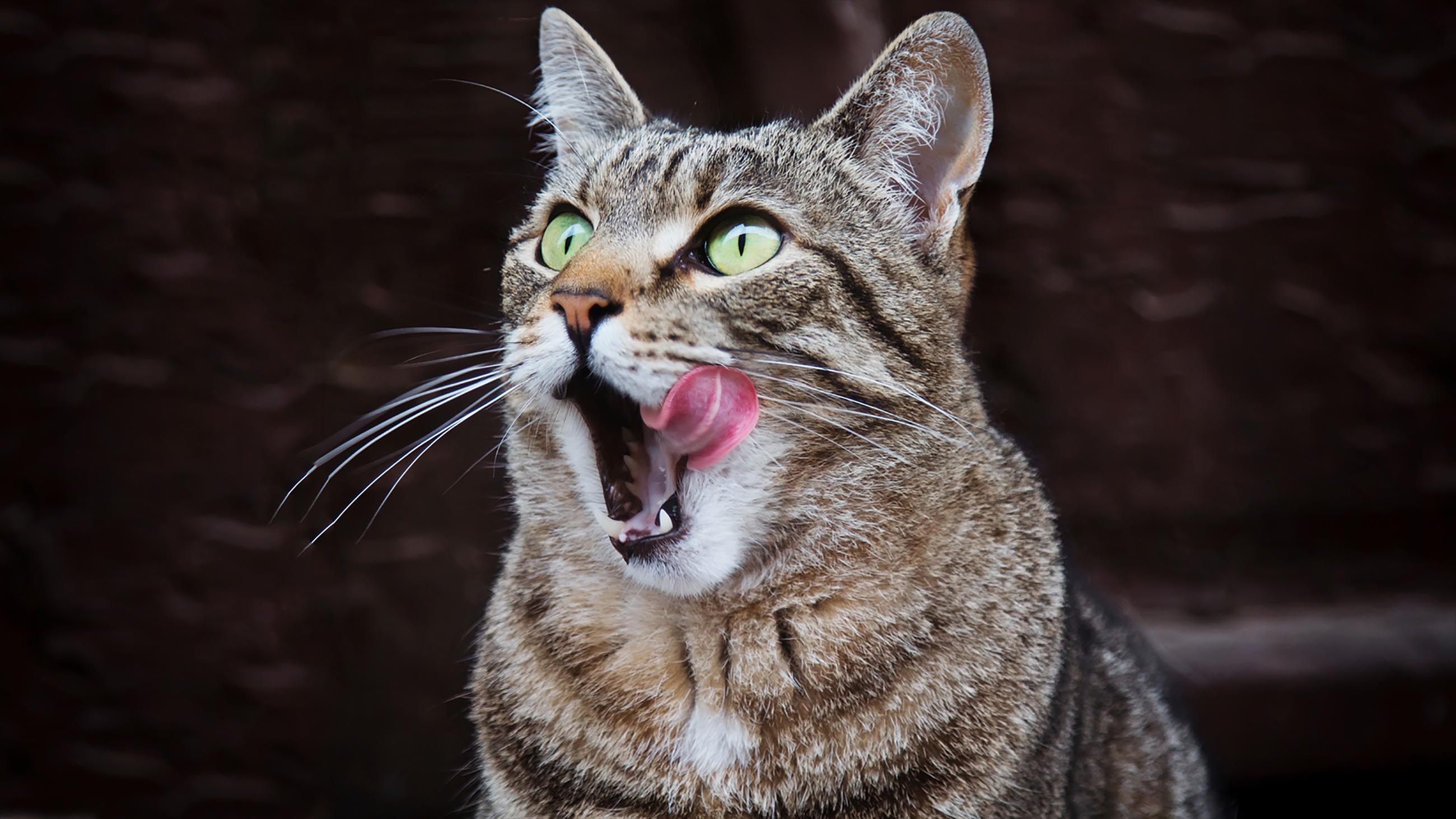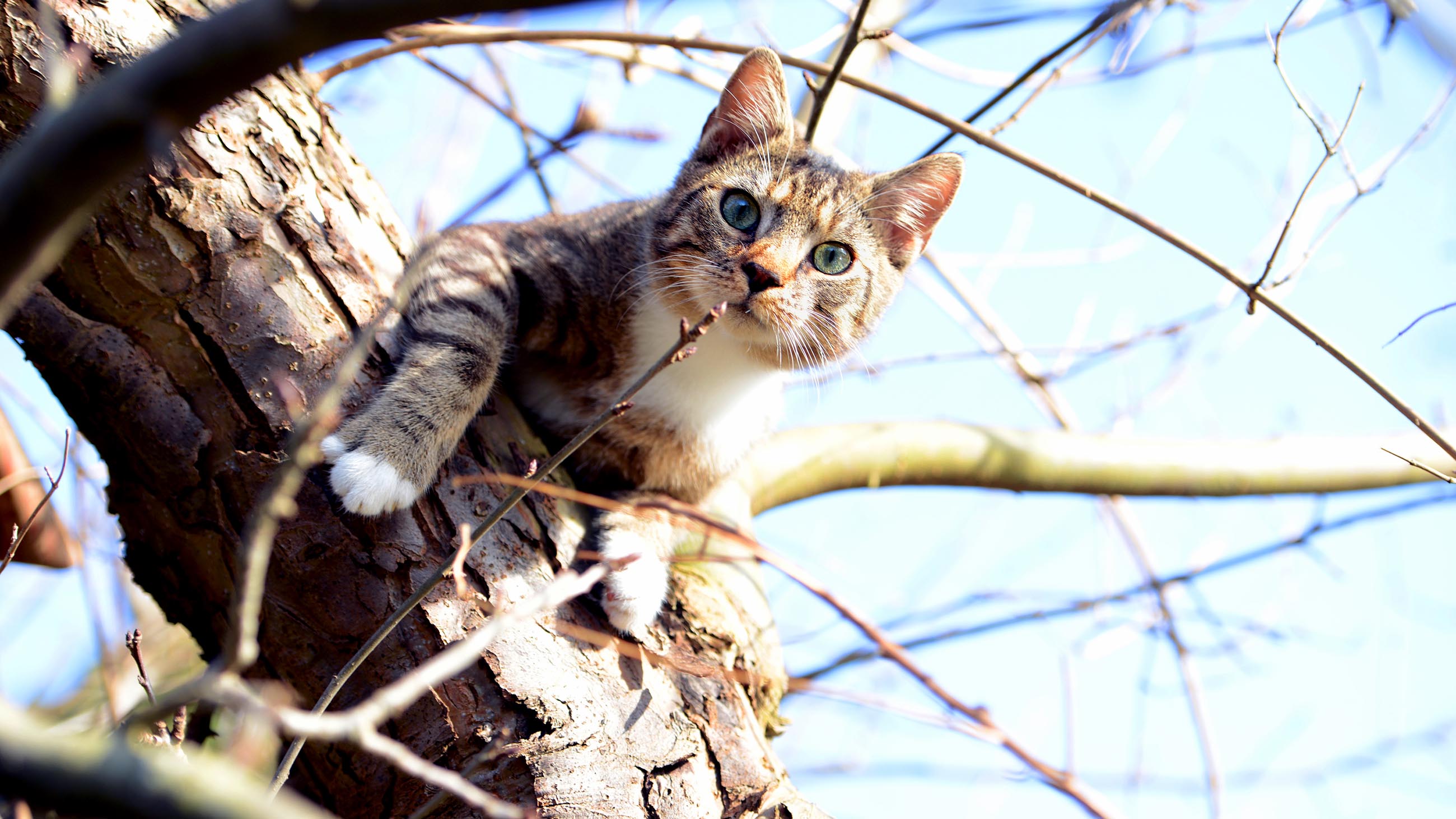In early 2013, Peter Marra, the head of the Smithsonian Migratory Bird Center, published a stark report on America’s outdoor cats. In the seven-page paper, Marra and two of his colleagues estimated that free-ranging felines — unowned feral cats and pets allowed to roam outside — are decimating our wildlife, killing a median of 2.4 billion birds and 12.3 billion mammals every year. The New York Times announced the findings with a provocative headline — “That Cuddly Kitty Is Deadlier Than You Think” — and photo: a green-eyed orange tabby with a limp brown rabbit in its mouth.

BOOK REVIEW — “Cat Wars: The Devastating Consequences of a Cuddly Killer,” by Peter P. Marra and Chris Santella. (Princeton University Press. 216 pages.)
Fur flew. The article attracted nearly 1,700 online comments, many of them outraged. “If I see a cat on my property I know it is going after the birds in my little sanctuary,” one reader posted. “If I could get away with it I’d kill it.” Others, however, challenged the researchers’ findings—“With those numbers we should be tripping over carcasses!”—and insisted that the scientists were persecuting cats: “I’m tired of everyone putting down cats and trying to justify their extermination.”
It wasn’t the first time Marra’s research had stirred up controversy, and now he has waded right back into it with his comprehensive new book, “Cat Wars,” which makes a convincing case that unconfined felines are taking a major toll on wildlife — and putting cat lovers and bird lovers on an ugly collision course. “More and more people are valuing birds and swelling the ranks of bird-watchers,” Marra and his co-author, Chris Santella, write. “Likewise, there are more cat owners in America now than at any time in history. As each side has swelled in numbers, the stage has been set for ‘bird people’ and ‘cat people’ to square off, forgetting, perhaps, that they are all animal lovers in the first place.” The war — call it Big Cat vs. Big Bird — is on. And right now, we’re all losing.
Though it is difficult to pin down their exact origin, domestic cats probably emerged in the Fertile Crescent, in the Middle East, after the invention of agriculture. Farms attracted rodents and birds, which in turn lured wild cats. Over generations, the tamest and most human-friendly felines diverged from their wild relatives, multiplied like rabbits (females average three litters a year), and spread to nearly every landmass on Earth. Today, there are 90 million pet cats in the U.S. alone, and an estimated 60 million to 100 million more that are unowned — though the true number of feral cats roaming the American landscape is unknown.
Unlike rabbits, however, “cats are generalized and opportunistic predators — they will kill anything that moves and is within their size range,” Marra and Santella write. The scale of predation is tricky to estimate, but numerous studies suggest that it’s significant — and may accelerate the decline of bird, mammal, and reptile populations. Cats can have a particularly devastating effect on islands, where small animals may have evolved without predators; in a 2011 paper, researchers calculated that feral cats were at least partly responsible for the extinction of 33 different island-dwelling species. On top of all that, outdoor cats spread disease, including rabies, toxoplasmosis, and the occasional case of bubonic plague.
For Marra and Santella, and for many other biologists, these facts add up to one conclusion: “From a conservation ecology perspective, the most desirable solution seems clear — remove all free-ranging cats from the landscape by any means necessary.” Sometimes, they say, the required measures are lethal ones, such as trapping and euthanizing feral cats or deploying poisoned bait. “No one likes the idea of killing cats,” Marra and Santella write. “But sometimes it is necessary.”
None of this has gone over well with cat lovers, who point out — correctly — that wild animals face many serious threats and that it’s difficult to prove that cats are to blame for species extinctions and declines. While many cat champions concede that too many unowned felines are skulking through the streets, they vehemently oppose lethal forms of population control. Instead, they advocate a model known as trap-neuter-return (TNR), in which volunteers trap feral cats, take them to be vaccinated and spayed or neutered, and then return them to their colonies. (Volunteers frequently provide ongoing care for these colonies, supplying food and shelter.)
Although Marra and Santella allow that “people who care for free-ranging cats are well intentioned,” they argue that TNR programs rarely spay and neuter enough cats to curb population growth — and note that even sterilized cats will continue to prey on wildlife. Many bird lovers reject TNR, and some are so infuriated by the maintenance of large outdoor cat colonies — a practice that the president of the American Bird Conservancy referred to as “open-air cat hoarding” — that they’ve taken matters into their own hands; in 2006, a Texas man was arrested for shooting a feral cat he spotted stalking an endangered piping plover.

Neither side in the cat wars has an unblemished claim to the moral high ground. Some cat lovers traffic in outright denial, refusing to even entertain the possibility that Kitty might be killing birds. Many seem to willfully misread what scientists like Marra are actually proposing, which is not the mass murder of cats but complex, multipronged solutions that may, in some circumstances, include euthanasia.
The conservation biologists and birders, on the other hand, tend to dismiss their opponents as irrational and overly emotional, resistant to real solutions because they have been blinded by cats’ cuteness. They have also been too quick to judge TNR a categorical failure. Marra and Santella simultaneously assert that “the scientific data make it impossible to advocate for TNR” and that “only one truly rigorous analysis has examined the impact of TNR in reducing free-ranging cat populations from a long-term quantitative and population modeling perspective.”
Activists on both sides are prone to hyperbolic, inflammatory rhetoric, and accusations of “genocide” have flown in both directions. And while only a few fanatics resort to threats or actual violence, such tactics are unacceptable and unproductive, whether directed at researchers or neighborhood cats.
Marra and Santella seem genuinely dismayed that the cat wars have grown so heated. Unfortunately, however, they have fanned the flames. Although the book is mostly measured, the authors’ call to remove cats from the landscape “by any means necessary” has drawn particular ire. Princeton University Press, which published “Cat Wars,” issued a statement clarifying that neither it nor the authors “support the inhumane treatment of animals,” but that seemed to make little difference. Amazon reviewers have not been kind, and nearly 3,000 people have signed a petition to boycott the publisher.
So where do we go from here? While science can help illuminate the problem, the cat wars are fundamentally about values, not data. Animal welfare advocates aren’t wrong when they argue that it’s unethical to kill one animal to save another, but neither are environmental ethicists wrong to say that the life of an individual animal shouldn’t take precedence over the good of an entire species.
Yet it is possible to stake out a middle ground. We should begin by acknowledging two non-contradictory principles: First, the numbers of free-ranging cats should be reduced. And second, just because cats are predatory, invasive, and (in some cases) unowned, that doesn’t mean their lives have no value.
Then we need to invest in an array of complementary solutions, beginning with humane population control. While trap-neuter-return may have shortcomings, it’s too soon to entirely dismiss the approach. Many TNR programs are scattershot, underfunded, volunteer-led efforts; giving them real financial support and infrastructure could significantly boost sterilization rates. Although Marra and Santella remain skeptical about TNR, they also outline some common-sense suggestions for improving it, including microchipping, collaring, and regularly monitoring released cats; moving colonies away from the most ecologically sensitive areas; and providing formal training and certification to the people who care for these colonies. When possible, we should also seek to place some of these trapped cats into pet homes and cat sanctuaries, rather than releasing them into the wild, and euthanasia should be considered for cats that are acutely ill. And along the way, we must conduct more rigorous research into the effectiveness of these strategies.
Even with these upgrades, though, TNR alone isn’t enough. “We must act on many different fronts to reduce the populations of free-ranging cats and reduce their impact on native animal populations,” Marra and Santella write. Perhaps the most critical is educating cat owners about the importance of sterilizing their pets, the advantages of keeping cats indoors, and alternatives to abandoning unwanted cats on the street. Laws should require cats to be spayed or neutered, as well as microchipped and licensed. (Licensing fees could be used to help fund population control measures, as Marra and Santella suggest.) It may also be worth exploring leash laws for pet cats, restricting cat ownership in the most critical wildlife habitats, and imposing fines on people who feed feral cats without participating in formal colony management programs.
Together, these sorts of measures — which will leave some cats on the landscape but aim to reduce their numbers systematically, while simultaneously imposing new restrictions on cat owners and advocates — are unlikely to satisfy either side completely. That’s usually a sign of a good compromise.
Emily Anthes, who has written for Undark, The New York Times, The New Yorker, Wired, and Scientific American, among other publications, is the author of “Frankenstein’s Cat: Cuddling Up to Biotech’s Brave New Beasts.”











Comments are automatically closed one year after article publication. Archived comments are below.
Feral cats keep the rodent population down.
Here in los Angeles we have a huge rat problem.
These rat are the size of footballs.
Australia will get their karma by being invested with other pest.
I lived on an island where there were many feral cats, as well as chickens, in addition to the normal creatures that inhabit tropical islands. An ecologist was hired to examine the ecosystem, and they concluded that the cats must go, as they pose a threat to the native bird population. So the cats were exterminated.
It appears that the cats were the only thing keeping the rat population under control. The rats population exploded, and we discovered that the rats were much more dangerous to the birds than the cats ever were. Plus, the rats got into stored food, ate through wiring in residences, and bit sleeping people.
Ecosystems are complicated things, and tinkering with them can have unexpected and unwelcome effects. It may be that the cats in your neighborhood are just filling a niche that used to be occupied by other predators.
My cat is an indoor cat, she gets supervised access to the outside (which she loves) on a leash. She gets to hunt birds through the window, and is very adept at hunting insects. She has brought us any dead animals, but I feel if one got in to the house she’d have it dead in short shrift.
Wild cat populations Start right w that owner willing to let them be outdoor cats…or letting them out feeling it’s better then it being in the house…but it all Started w ppl…blame cats blame wildlife blame Rats…but look at rats breeding in urban areas gather up those feral cats and set them after rat populations
And the Economy system is a Balance…when foreign animals that don’t belong end up being Devestating to the habit then the food chain breaks down…
Cats rock! Dogs rock too! However, humans fail these domesticated animals again and again. It took forever to make animal abuse a felony and have courtrooms take such matters seriously. I await a national animal abuser registrar. They are not things or property. They rely on humans for their care. We owe them much and yet we fall short. And to hell with the guy who thinks killing feral cats! They are feral cuz some schmuck of a human didn’t care about abandoning their cat.
I, on the other hand believe ‘no-kill’ cat advocates should be defined as bioterrorists, and punished accordingly. They deliberately expose human communities to potentially fatal cat-vectored diseases, proliferate the infectious agents of such diseases in our environment–including our drinking water and food supplies.
I’ve already refuted the “kitties saved us from plague” fallacy in my previous post, and am prepared to post links to scientific studies which disprove it.
Incorrect. Cats did nothing whatsoever to fight bubonic, pneumonic or septicemic plague (Yersinsia pestis). The only role cats played during the 14th century European plague pandemic and its lesser ‘sequels’ (outbreaks) was to catch plague and die from it–after transmitting it to something else.
Cats are particularly susceptible to plague. There have been six cases of cat-vectored plague in Colorado and Wyoming since last July. Transmission to humans was in all recent cases via infectious respiratory droplets because humans allowed close contact with cats.
The primary way humans have shunned responsibility concerning feral cats is by adopting worthless ‘no-kill’ strategies rather than taking aggressive pest-control approaches to reduce and eliminate feral populations. As a direct result of this–particularly the fraudulent practice known as “TNR”–1/3rd of all human rabies exposures are due to feral and free-roaming cats. That’s about 13,000 exposures per year for at least the last 15 years, each requiring painful and expensive PEP (Post Exposure Prophylactic) inoculations at $3,000.00-$26,000.00 per person.
Another consequence of TNR is that the infectious oocysts of the cat-vectored parasite Toxoplasma gondii are now present in our environment at densities of from three to 434 oocysts per square foot, and they persist in the environment and remain infectious for 1.5 to 4.5 years. They contaminate vegetable gardens, row-crop soils, pastures, livestock and game animal browsing areas, improperly-filtered municipal and rural water supplies, inshore marine habitat and the filter-feeding organisms therein, as well as parks, schoolyards and children’s play areas. The oocysts can and do become aerosolized. All it takes is inhaling one oocyst to blind, permanently debilitate or kill a child. Or immuno-compromised adult.
As many as 1/5th of the U.S. population is infected with toxoplasmosis. Most are asymptomatic because healthy immune systems usually suppress the parasite’s deleterious effects. Nonetheless per the CDC 4,500 Americans are hospitalized each year due to toxoplasmosis-induced food-borne illness, and about 325 of them die. Toxoplasmosis causes 400 to 4,000 stillborn, blind, hydrocephalic, microcephalic and severely mentally retarded newborns annually, and no one knows how many chronic miscarriages in childbearing age women. Ocular lesions caused by the parasite blind 70 people–mostly children–annually. The parasite has also been linked to adult-onset schizophrenia.
In addition to ingestion, inhalation and congenital (intrauterine) transmission, the infectious oocysts can be transmitted via breast milk and semen. And no one’s immune system remains healthy forever–they deteriorate with age. Those irresponsible individuals who maintain disease ridden animals at unnaturally high densities by subsidizing them with food, thus attracting them to human-inhabited areas, have essentially decided to risk shortening their neighbors’ life spans by needlessly exposing them to zoonotic disease.
If such people became enamored of rats and wanted to feed and maintain them in colonies via TNR, they would be hauled off and institutionalized as menaces to public health–and rightly so. Cats carry far more potentially-fatal diseases transmissible to humans than do rats.
And these myopic, outdoor TNR cat-hoarders who foster them are modern-day equivalents to Typhoid Mary–they won’t stop because all they care about is preventing cats from being euthanized, no matter the cost to their communities.
Dr. Marra is correct–these invasive, disease-ridden vermin must be removed from the landscape by any means necessary. That means ‘feral’, ‘stray’, ‘community’, ‘barn’, ‘colony’, ‘free-roaming pet’ and “I’m too pathetic and lazy to make a 12 lb. domesticated animal stay in the house” cat.
I couldn’t agree more
Toxoplasmosis is one of the most common parasites in the world and not just transmitted by cat feces.
https://www.mayoclinic.org/diseases-conditions/toxoplasmosis/symptoms-causes/syc-20356249
Dogs are just as much of a rabies vector as cats, maybe even more so. Your research is very biased and you are guilty of extreme confidence bias. Why don’t you just admit to being a hysterical cat hater?
https://www.cdc.gov/rabies/exposure/animals/domestic.html
It’s amazing to me how delusional people are. Cats are overpopulating the planet now because they hitched their pony to the wagon of the human species, which is overpopulating the planet… As a matter of fact, cats helped human progress by fighting the plague and supporting larger crops by fighting rodents, etc. The ability of humankind to be delusional and shun responsibility is amazing. Humans should only be thanking cats…